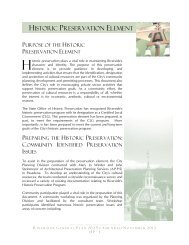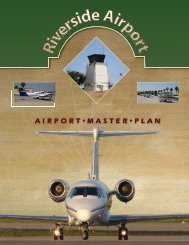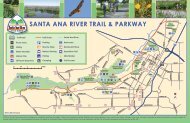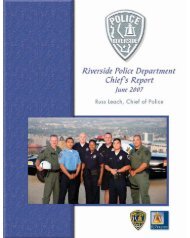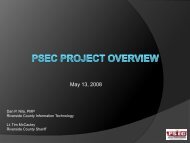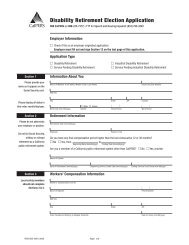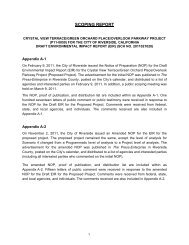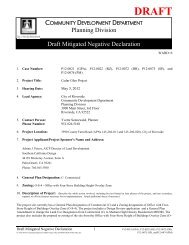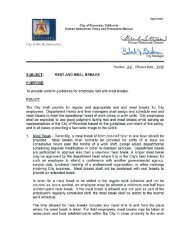Northside - City of Riverside
Northside - City of Riverside
Northside - City of Riverside
You also want an ePaper? Increase the reach of your titles
YUMPU automatically turns print PDFs into web optimized ePapers that Google loves.
formation <strong>of</strong> the <strong>Riverside</strong> Community Players (1925), the <strong>Riverside</strong> Art Association<br />
(1931), and the <strong>Riverside</strong> Opera Association (1932) (Patterson 1996:383,402). In the<br />
depressed 1930s, local public projects benefited from national relief programs like<br />
the Works Progress Administration (WPA), which assisted in the construction <strong>of</strong><br />
public improvements, such as the concrete parking stops installed along North Main<br />
Street shops, and also contributed to arts and education projects like the<br />
construction <strong>of</strong> a new building for the Chemawa Junior High School (1928) in 1939-<br />
40 (demolished 1973).<br />
According to <strong>Riverside</strong> census records, from 1910 to 1940 the <strong>City</strong>’s population more<br />
than doubled from 15,212 to 34,696, with the largest increase <strong>of</strong> 10,355 new residents<br />
between 1920 and 1930. It is unclear how these figures represent the population<br />
growth within the <strong>Northside</strong>, specifically, but the onset <strong>of</strong> large-scale residential<br />
development there during this period evidences the relative increase to the boost in<br />
the larger <strong>Riverside</strong> population.<br />
RESIDENTIAL DEVELOPMENT<br />
In response to dramatic increases in population, residential development in<br />
<strong>Riverside</strong> increased again in the peacetime climate between WWI and WWII, which<br />
was typical throughout southern California. In <strong>Riverside</strong>, previously undeveloped<br />
land was subdivided as new residential tracts were developed. Extensive grove and<br />
agricultural properties were carved up, and new, smaller homes were built near<br />
large grove houses or filled in vacant residential lots (RCPD February 2003:16). On<br />
the <strong>Northside</strong>, however, much <strong>of</strong> the land within the survey area had already been<br />
readied for development, and within this period, only two tracts were developed in<br />
the Fairmount Heights area <strong>of</strong> the <strong>Northside</strong> – the Redwood Tract (1924), which<br />
resubdivided the 1916 Amended Indian Hill Tract, and <strong>City</strong> Park Tract (1926). In the<br />
Southeast Quadrant, Russell Tract Nos. 1 & 2 (1936, 1937) and the Rusora Tract<br />
(1937) were developed, and developers began to consider the area in the northeast<br />
area <strong>of</strong> the Southeast Quadrant, now the Freeway Industrial Interchange, and the<br />
C.C. Pond Subdivision (1941) was laid out there (Figure 16). Speculation in this area<br />
may have waited too long. WWII slowed development, and by the time the war<br />
came to a close, the area appeared suitable for large-scale industrial and<br />
manufacturing.<br />
Area <strong>of</strong> Development Tracts Date Map Book/Page<br />
Fairmount Heights Redwood Tract 1924 11/77<br />
<strong>City</strong> Park Tract 1926 13/82<br />
Freeway Industrial<br />
Interchange<br />
C.C. Pond Subdivision 1941 20/7<br />
103



